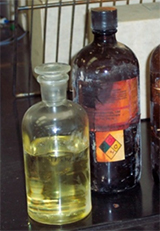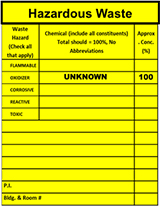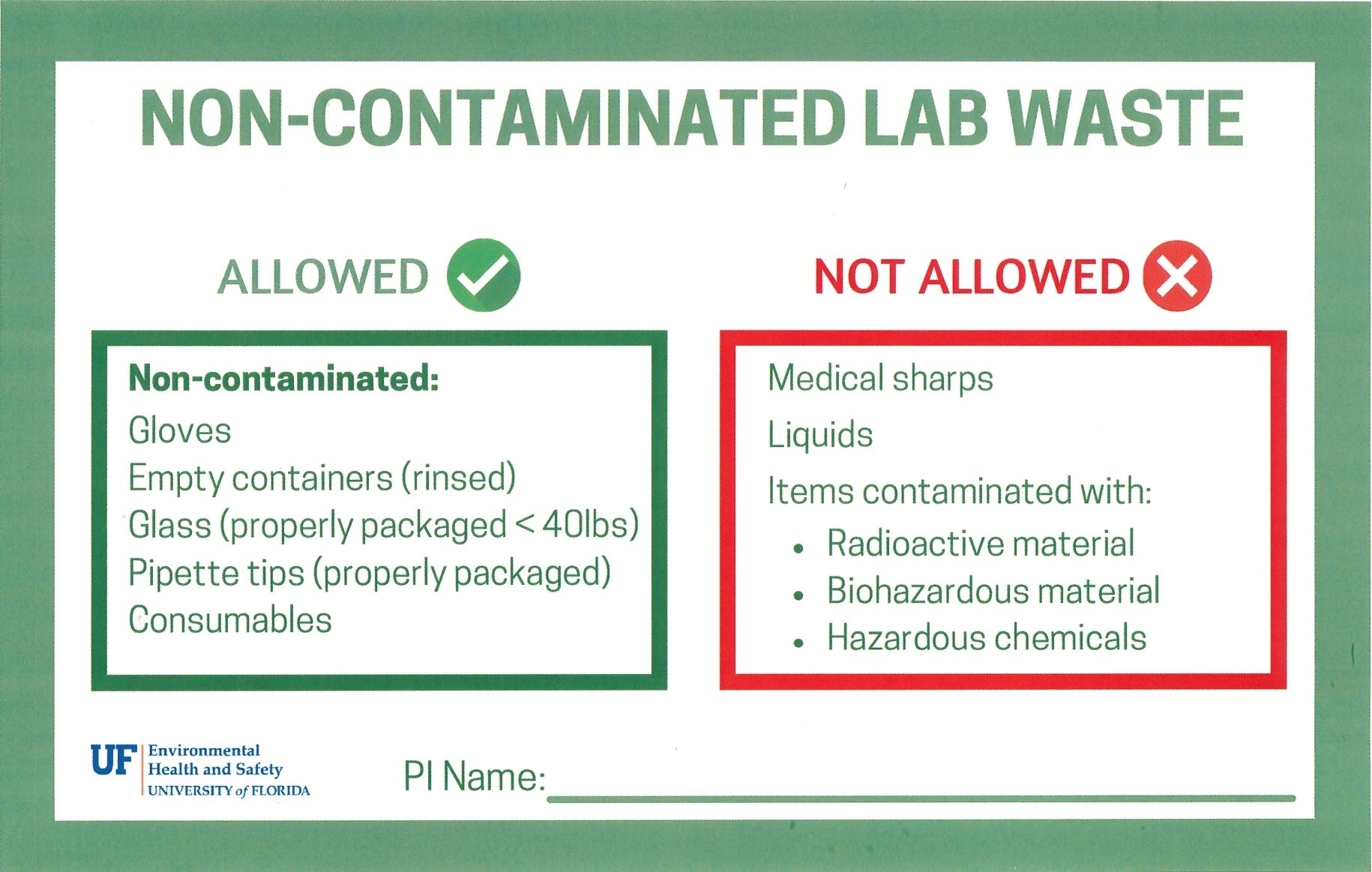
Laboratory Waste
Managing Liquid Hazardous Wastes
- Containers must be closed at all times except when physically adding waste
- Containers must be labelled with all chemical constituents (and their approximate % by volume), including water
- Leave adequate headspace in liquid containers (~1” is sufficient for a 4L container; leave more or less depending on the size of your waste container)
Flammable Liquids and Solvent Wastes
- For small quantities (<5 gallons), accumulate in glass bottles
- For larger quantities (>5 gallons), accumulate in metal cans
Corrosive Liquid Wastes
- Segregate acidic wastes from alkaline wastes within SAA (separate via secondary containment)
- Never accumulate corrosive liquids in a metal container
- Always accumulate hydrofluoric acid (“HF”) in a plastic container;
- Do not dispose of liquid-containing vials in the same container as solid waste
- Identify all chemical hazards on hazardous waste labels
- Do not include regular trash or Non Regulated Lab Waste in solid waste debris
- 5-gallon plastic buckets and 30-gallon fiberboard drums(with plastic liner) for solid waste accumulation are available from EH&S by calling 392-8400
In an effort to correctly manage all types of solid waste generated in laboratories while minimizing the amount of Hazardous Waste created, the University of Florida has adopted the following policy regarding the disposal of clean (i.e. non-contaminated) lab wares.
These laboratory items may be disposed of as “Non-Contaminated Lab Waste,” provided that the item is clean and is not contaminated with hazardous chemicals, radiological materials, or biohazardous materials. Labels are available through lab safety at Lab Signage – UF | EHS.
Agarose/Polyacrylamide Gels
Protocols which require the use of electrophoresis gels require several specific waste management procedures to be in place. The following are general guidelines for electrophoresis-related waste.
Ethidium Bromide is a commonly-used chemical in the electrophoresis process. Ethidium Bromide (“EtBr”) is a suspected mutagen; for this reason, the University of Florida requires lab workers to handle both concentrated stock solutions containing Ethidium Bromide, as well as agarose gels stained with Ethidium Bromide as Hazardous Waste.
- There are many other products currently on the market which mimic the performance of Ethidium Bromide, but which are notconsidered hazardous waste once they are spent. Dilute solutions of these products, along with the associated de-stained gels, may be drain disposed (if liquid waste) or disposed of as Clean Lab Ware (if solid waste). The following products have been researched and determined to be less-hazardous than Ethidium Bromide, and wastes may be managed using these less-stringent methods: SYBR Green, SYBR Safe, GEL RED Unused portions of these products, however, because of their higher concentrations, must be disposed of through EH&S as hazardous waste.
- Several other dyes common in the electrophoresis process include xylene cyanol, methylene blue, bromophenol blue, and cresol red. Unused portions of these dyes should be turned over to EH&S for disposal as hazardous waste, while dilute aqueous solutions containing the dyes may be disposed of down sink drains as long as no other hazardous materials are also present in the waste. These dyes are commonly combined with flammable solvents such as xylene, methanol, or alcohols; if waste solutions contain any concentration of these solvents, labs should manage the waste as hazardous waste.
Environmental Health and Safety’s Hazardous Waste Management can provide containers for electrophoresis waste collection at no charge to UF labs. 5-gallon plastic buckets are commonly used to contain agarose gel waste, while bottles or carboys will be provided for collection of liquid wastes. To request a container delivery, call 392-8400.
All stained gels, dyes, and concentrated stock solutions should be managed as Hazardous Waste
Solid waste containers should be labeled with all contaminants and be free of liquids
Manage silver stain waste separately
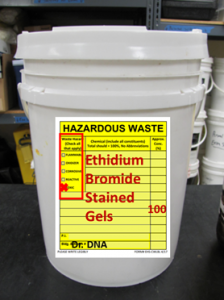
Wet chemistry photography may seem like a thing of the past, but there are still darkrooms on campus. If you are still using one we would encourage you to plumb in a silver recovery unit. This will allow your photo processor to be plumbed directly to the drain and reduce your hazardous waste generation. See below for the correct disposal of common photographic wastes:
Drain Disposal |
|
Film |
|
Hazardous Waste |
|
Gas Cylinders
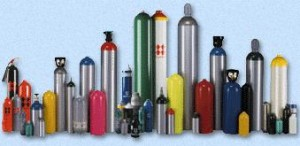 Prior to ordering pressurized gas cylinders for their research projects, Principal Investigators and lab members are directed to contact the manufacturer or cylinder supplier and make arrangements to have the cylinders picked up following use.
Prior to ordering pressurized gas cylinders for their research projects, Principal Investigators and lab members are directed to contact the manufacturer or cylinder supplier and make arrangements to have the cylinders picked up following use.
In the event that a lab discovers an old or abandoned cylinder in their spaces, they should contact EH&S’s Chemical and Radioactive Waste Disposal group immediately to aid with disposal.
Aerosol Cans
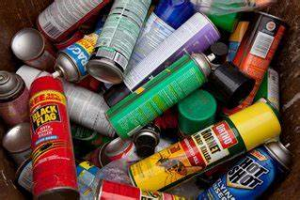 Aerosol cans which are empty of all contents are allowed to be disposed of as “regular” trash by placing in any waste receptacle. If there are contents still in the can, however, the aerosol product should be placed in an appropriate outer container (such as a fiberboard drum) in the lab’s Hazardous Waste Satellite Accumulation Area and disposed of through EH&S.
Aerosol cans which are empty of all contents are allowed to be disposed of as “regular” trash by placing in any waste receptacle. If there are contents still in the can, however, the aerosol product should be placed in an appropriate outer container (such as a fiberboard drum) in the lab’s Hazardous Waste Satellite Accumulation Area and disposed of through EH&S.
Potentially Unstable Wastes
Many commonly-used reagents in research laboratories have the tendency over time to chemically decompose, resulting in highly flammable or sometimes even shock-sensitive compounds. Over time, these unstable wastes can decompose to the point where they present significant personnel dangers. For this reason, the University of Florida has the following policies regarding the storage of these chemicals:
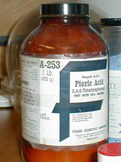 Dinitro- and trinitro- compounds: should be disposed of through EH&S as hazardous waste once the compound is noted to be undergoing physical change. If the product is past its printed expiration date or is exhibiting signs of drying or crystallization. It should be disposed of through EH&S. Contact EH&S if you discover very old containers or containers with metallic lids. Dinitro- and trinitro- compounds: should be disposed of through EH&S as hazardous waste once the compound is noted to be undergoing physical change. If the product is past its printed expiration date or is exhibiting signs of drying or crystallization. It should be disposed of through EH&S. Contact EH&S if you discover very old containers or containers with metallic lids. |
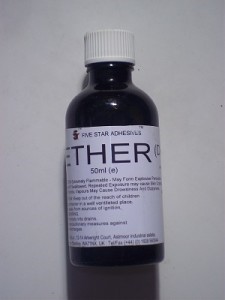 Peroxide Forming Chemicals: many common organic chemicals and some common inorganic chemicals can form potentially explosive peroxides during storage following exposure to atmospheric oxygen and UV radiation. To prevent peroxide formation and to promote disposal of potentially unstable chemicals, items listed in the table below should be stored in tightly closed containers, away from light and disposed of after their useful lifespan. To track the lifespan, these chemicals should be dated upon receipt and dated upon first opening. Peroxide Forming Chemicals: many common organic chemicals and some common inorganic chemicals can form potentially explosive peroxides during storage following exposure to atmospheric oxygen and UV radiation. To prevent peroxide formation and to promote disposal of potentially unstable chemicals, items listed in the table below should be stored in tightly closed containers, away from light and disposed of after their useful lifespan. To track the lifespan, these chemicals should be dated upon receipt and dated upon first opening. |
Table of Peroxide Forming Chemicals
| Chemicals that form explosive levels of peroxides without concentration-Dispose of within 3 months of opening | |||
| Butadiene a | Divinylacetylene | Tetrafluoroethylene a | Sodium Amide |
| Chloroprene a | Isopropyl Ether | Vinylidine chloride | Potassium metal |
| Potassium amide | |||
| Chemicals that form explosive levels of peroxides on concentration-Dispose of within 6 months of opening | |||
| Acetal | Decahydronaphthalene | 2-Hexanol | 2-Phenylethanol |
| Acetaldehyde | Diacetylene | Methylacetylene | 2-Propanol |
| Benzyl Alcohol | Dicyclopentadiene | 3-methyl-1-butanol | Tetrahydrofuran |
| 2-Butanol | Diethyl ether | Methylcyclopentane | Tetrahydronaphthalene |
| Chlorofluoroethylene | Diethylene glycol dimethyl ether (diglyme) | Methyl isobutyl ketone | Vinyl Ethers |
| Cumene | Dioxanes | 4-Methyl-2-pentanol | Other secondary alcohols |
| Cyclohexanol | Ethylene glycol dimethyl ether (glyme) | 2-Pentanol | |
| 2-Cyclohexen-1-ol | Furan | 4-Penten-1-ol | |
| Cyclohexene | 4-Heptanol | 1-Phenylethanol | |
| Chemicals that may autopolymerize due to peroxide formation-Dispose of within 12 months/immediately * | |||
| Acrylic acid | Chlortrifluoroethylene | Vinyl acetate | Vinyladiene chloride |
| Acrylonitrile | Methyl methacrylate | Vinylacetylene | |
| Butadiene | Styrene | Vinyl chloride | |
| Chloroprene | Tetrafluoroethylene | Vinylpyridine | |
|
* – inhibited chemicals can be stored for 12 months, uninhibited should be disposed of immediately. |
|||
Laboratories which accumulate used oil from vacuum pumps or other pieces of lab equipment must not mix this oil with other chemical wastes; this segregation allows the university to recycle the oil, thereby minimizing waste generation. Below is a list of how to manage used oil:
Pump Oil, Heating Baths, etc.
Must be drained from equipment.
Labeled “USED OIL”
Labels available from EH&S
Oil contained within equipment designated for disposal (x-ray machines, pumps, transformers, etc.) must be sampled and tested prior to disposal of the equipment. EH&S personnel will conduct tests for Poly Chlorinated Biphenyls (“PCBs,” a toxin often present in older pieces of electrical machinery). If tests for PCBs are positive, EH&S will assist in the disposal of these.
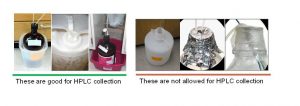 High Performance Liquid Chromatography (HPLC) equipment often creates hazardous liquid waste. The process frequently results in wastes which contain flammable solvents such as acetonitrile or methanol, and these are often mixed with acidic components such as formic or trifluoroacetic acid.
High Performance Liquid Chromatography (HPLC) equipment often creates hazardous liquid waste. The process frequently results in wastes which contain flammable solvents such as acetonitrile or methanol, and these are often mixed with acidic components such as formic or trifluoroacetic acid.
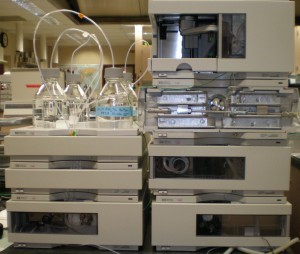 The hazardous effluent from the HPLC equipment must be collected in closed containers. Labs may purchase purpose-built collection caps/containers for this; an easy solution, however, is to simply drill holes through the cap of any suitable container and route the effluent lines through those ports.
The hazardous effluent from the HPLC equipment must be collected in closed containers. Labs may purchase purpose-built collection caps/containers for this; an easy solution, however, is to simply drill holes through the cap of any suitable container and route the effluent lines through those ports.
Labs which generate small vials, conical tubes, centrifuge tubes, etc. which contain liquid hazardous waste do not need to individually pour out these small amounts of liquid. They may be managed following these guidelines:
Container Label must describe ALL VIAL CONTENTS
ONLY VIALS in waste vial container, NO DEBRIS
SEPARATE ACID VIALS and SOLVENT VIALS

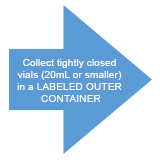
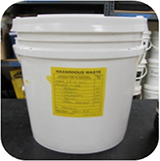
Pharmaceutical Waste must be disposed of as Chemical Waste through EH&S
Many chemical and/or pharmaceutical compounds used in research or in the treatment of disease at the University of Florida are regulated by the EPA as listed or characteristic hazardous wastes when disposed. Many other pharmaceutical compounds are not regulated as hazardous waste but may pose a threat to human health or the environment and have the potential to be misused. All unusable prescription or non-prescription pharmaceuticals and pharmaceutical compounds used in treatment or research should be disposed of through EH&S as Hazardous Waste.
A limited number of prescription pharmaceuticals and pharmaceutical compounds used in research and treatment are regulated by the Drug Enforcement Administration under the Controlled Substances Act. EH&S does not collect controlled substances for disposal.
Hazardous Waste Pharmaceuticals
Many chemical and/or pharmaceutical compounds used in research or in the treatment of disease at the University of Florida are regulated by the EPA as Listed or Characteristic Hazardous Wastes when disposed. The following lists are examples of some common Hazardous Waste Pharmaceuticals.
P-Listed Hazardous Waste Pharmaceuticals
Unused dilutions, formulations (including container rinsates) or wastes generated through spillage of the original product are considered hazardous waste. Packaging and/or empty containers associated with these items must either be collected as hazardous waste or triple-rinsed before being considered empty.
| P012 | Arsenic Trioxide | P081 | Nitroglycerin | |
| P042 | Epinephrine | P188 | Physostigmine salicylate | |
| P046 | Phentermine | P204 | Physostygmine | |
| P075 | Nicotine and Salts |
U-Listed Hazardous Waste Pharmaceuticals
Unused dilutions or formulations or wastes generated through spillage of the original product are considered hazardous waste. Personal Protective Equipment PPE contaminated during use or preparation of Chemotherapy agents should be collected as hazardous waste.
| U010 | Mytomycin C | U058 | Cyclophosphamide |
| U035 | Chlorambucil | U059 | Daunomycin |
| U052 | Cresol | U055 | Cumene |
Characteristic Hazardous Waste Pharmaceuticals
Pharmaceutical chemicals or formulations may also contain components which are regulated as characteristic waste. The presence of these components is often present only as a component (often a minor constituent) and not clearly identified in labeling. The EPA regulates Toxicity Characteristic chemicals at the parts per million (ppm) level. Knowledge and understanding of the entirety of product make-up is critical for safety and proper waste determination.
| Thimerosol, Merthiolate | Toxic (Mercury) | Silvadene | Toxic (Silver) | ||
| Barium Sulfate | Toxic (Barium) | Insulin | Toxic (m-Cresol) | ||
| Mercurochrome | Toxic (Mercury) | Styptic Pens | Toxic (Silver) | ||
| Selenium Sulfide | Toxic (Selenium) | ||||
Prescription and Non-Prescription Pharmaceuticals
Pharmaceutical Waste must be disposed of as Chemical Waste through EH&S
Prescription and “over the counter,” non-prescription pharmaceutical waste generated while in use at the Student Infirmary or Veterinary Hospital should be disposed of as Hazardous Waste through EH&S. Prescription Pharmaceutical wastes also include solutions and formulations not in the original packaging (IV bags, etc). Pharmaceutical waste does NOT include Sharps or other material considered to be Medical or Bio-Hazard Waste (IV sets, syringes, needles, etc). Unopened pharmaceuticals should be returned for credit through a pharmaceutical reverse distributor. UF is not responsible for the disposal of unused personal or pet prescriptions. Personal prescriptions may be disposed of through the Alachua County Disposal of Unwanted Medicines program.
Disposal of Controlled substances
The Drug Enforcement Agency’s (DEA) Office of Diversion Control regulates the disposal of DEA controlled substances.
Proper use and disposal of DEA controlled substances is the responsibility of the individual holding the DEA registration used to obtain them. Maintaining accurate and current records of usage and maintaining a current DEA registration are critical for compliance with DEA regulations. Principle Investigators who “orphan” controlled substances by abandoning or losing control of them are in violation of federal law. Do not create orphan drugs. If drugs are found, contact Chemical and Radioactive Waste Disposal for assistance at (352) 392-8400.
Reverse Distribution
All reverse distributors have their own slightly different methods and requirements. The process typically involves most if not all of the following:
- Contact a Reverse Distribution Vendor to register.
- Complete the vendor’s application for approval to ship material – either in paper form and sent by mail / fax or in electronic form (both require current DEA registration).
- Additional Forms – Completing DEA D-222 form if necessary (for Schedule I & II controlled substances)
- Payment – payment or payment information is required with application.
- Shipping – once authorized, items are packaged and shipped by you via an approved shipper (Fed-Ex or UPS usually)
- Always request documentation of return/disposal/destruction
Reverse Distributor Vendor List
The following is a list of DEA registered reverse distributors licensed to provide return/disposal services in the State of Florida:
PharmaLink (800) 257-3527
Rx Reverse Distributors, Inc. (866) 388-7973
Triumverate, Inc. (888) 834-9697
Other Resources
- DEA Website: DEA Office of Diversion Control
- Information on Identifying Your Material: DEA Briefs & Background, Drug Policy, Drug Scheduling
- Definition of reverse distribution: Reverse Distribution
- DEA Forms: DEA Form D-222 and D-41
Proper labeling of all chemical containers by lab members will prevent the creation of dangerous, expensive-to-dispose chemical wastes of unknown origin. Before leaving a lab, workers must ensure that all chemical wastes that they have been responsible for creating are positively identified and labelled.
If lab workers come across old or abandoned chemicals of unknown origin or make-up, they are directed to label the container with a Hazardous Waste label, and write “UNKNOWN-100%” in the constituent section. Dispose of the unknown waste through EH&S as soon as possible to prevent an inadvertent personnel exposure to the unknown chemical. Every effort should be made to identify the chemical or its context. This will help EH&S staff in determining the best method for management.
